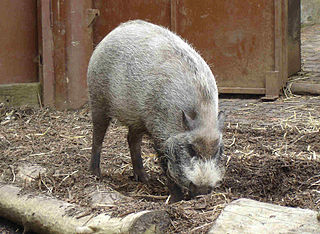
Arthur Gardiner Butler F.L.S., F.Z.S. was an English entomologist, arachnologist and ornithologist. He worked at the British Museum on the taxonomy of birds, insects, and spiders.

Blandfordia, commonly known as Christmas bells, is a genus of four species of flowering plants native to eastern Australia. Christmas bells are tufted, perennial herbs with narrow, linear leaves and up to twenty large, drooping, cylindrical or bell-shaped flowers.
Robert Fisher Tomes was an English farmer and zoologist.

Grantia is a genus of calcareous sponges belonging to the family Grantiidae. Species of the genus Grantia contain spicules and spongin fibers.

Kinixys is a genus of turtles in the family Testudinidae. The genus was erected by Thomas Bell in 1827. The species in the genus Kinixys are native to Sub-Saharan Africa and Madagascar and commonly known as hinged tortoises or hinge-back tortoises.

Suinae is a subfamily of artiodactyl mammals that includes several of the extant members of Suidae and their closest relatives – the domestic pig and related species, such as babirusas. Several extinct species within the Suidae are classified in subfamilies other than Suinae. However, the classification of the extinct members of the Suoidea – the larger group that includes the Suidae, the peccary family (Tayassuidae), and related extinct species – is controversial, and different classifications vary in the number of subfamilies within Suidae and their contents. Some classifications, such as the one proposed by paleontologist Jan van der Made in 2010, even exclude from Suinae some extant taxa of Suidae, placing these excluded taxa in other subfamilies.

The Littorinidae are a taxonomic family of over 200 species of sea snails, marine gastropod molluscs in the clade Littorinimorpha, commonly known as periwinkles and found worldwide.

Bittium is a genus of very small sea snails, marine gastropod molluscs in the family Cerithiidae, the horn snails.
Edward John Miers FZS FLS was a British zoologist and curator of the crustacean collection at the Natural History Museum in London. He contributed to the scientific reports from the Challenger expedition of 1872–1876, and described 32 new genera and at least 260 new species and subspecies of decapod crustaceans, along with four genera and 72 new species in other orders.

Rissoa is a genus of minute sea snails, marine gastropod mollusks or micromollusks in the family Rissoidae.

Cuninidae is a family of hydrozoans in the order Narcomedusae. They have dome-shaped bells and tentacles set above the undulating margin of the bell. Their gastric pouches contain the gonads situated in line with the tentacles, the number of pouches being the same as the number of tentacles. The pouches do not extend below the points of origin of the primary tentacles. Members of some genera have a peripheral canal system and others do not. No radial canals or secondary tentacles are present.
The Syncystidae are a family of parasitic alveolates in the phylum Apicomplexa. Species in this family infect insects (Aeshnidae).

Lipkea is a genus of stalked jellyfish. It is the only genus in the monotypic family Lipkeidae. Lipkea species lack tentacles at the end of their bell.

Eucalyptus johnstonii, commonly known as Tasmanian yellow gum, is a species of medium-sized to tall tree endemic to Tasmania. It has smooth yellow to greenish bark, lance-shaped adult leaves, flower buds in groups of three, white flowers and hemispherical or bell-shaped fruit.

Hoploparia is a genus of fossil lobster belonging to the family Nephropidae. The type species of this genus is Hoploparia longimana.
Syncystis is a genus of parasitic alveolates in the phylum Apicomplexa.

Pawsonia saxicola, the sea gherkin, is a species of sea cucumber in the family Cucumariidae. It is found in the northeastern Atlantic Ocean and the Mediterranean Sea.

Aslia lefevrii is a species of sea cucumber belonging to the family Cucumariidae.

Proviverrinae is an extinct subfamily of placental mammals within the extinct order Hyaenodonta. Fossil remains of these mammals are known from early to late Eocene deposits in Europe.














